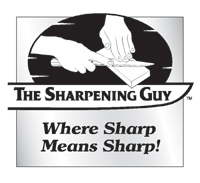Knife Sharpening
I examine every knife that I sharpen to check for damage and to assess the blade profile and geometry. Once I have fixed any damage, I will thin the blade down if needed by creating a back bevel behind the cutting edge. Finally, I expertly sharpen the edge bevel and hone it to razor sharpness. If you are getting Japanese style sharpening, then the edge bevel will be sharpened and honed on Japanese waterstones. On a carbon steel knife, I will also put a light coat of camellia oil on the blade to prevent rust.
Knife Repairs and Makeovers
If your knife blade has any damage to it (such as nicks, chips, bends, broken tips, etc.), I will repair it when I sharpen it. I also can repair and replace handles in many cases.
Knife makeovers are designed to bring the maximum performance and looks out of your knife. This often includes major thinning, polishing, etching (in the case of Damascus steel knives), rounding of the spine and choil, and so on.
Prices
-
Standard repairs $5.00 - $10.00
Bolster reduction, broken tip repair, blade shape restoration, bent tip repair, and re-serrating.
-
Extensive repairs estimate given when the item is received
Bolster reduction, broken tip repair, blade shape restoration, bent tip repair, re-serrating, blade thinning, and Japanese knife repair.
-
Knife makeover ask for quote
-
Handles ask for quote
Why thin a knife down?
- Thinner knives just cut better.
- Each time your knife is sharpened, a small amount of steel is removed from the edge of your knife. This moves your edge back into thicker steel. By thinning your knife down a little bit each time I sharpen it, I maintain the proper blade geometry for your knife.
- All good sharpeners thin knife blades. Without proper thinning, the knife won’t cut well.
Scissors and Shears
I sharpen household scissors, sewing shears, pinking shears, surgical scissors, industrial shears, manicure scissors, knife edge shears, salon shears, barber shears, grooming shears, and thinning shears.
Proper shear sharpening matters
- Extend the life of your shears with proper sharpening
- Your shears work properly the first time, allowing you to focus on your work using them.
Straight Razor Honing and Repair
I personally shave with a straight razor, and I would love to sharpen yours. I will hand hone it on Japanese waterstones, and then strop it until it is shave ready. I do not tape the spine of the razor. If it is a carbon steel razor, I will also put a light coat of camellia oil on the blade to prevent rust. I also have a free video showing you how to strop your razor so you can properly maintain the edge between honings.
Stropping your straight razor matters
- It removes any surface corrosion from the edge.
- It provides a more comfortable shave.
- It keeps your razor sharp for longer between honings.
Please note the following:
- Pocket knives are charged per blade.
- Extra charges may be made for items that need repair. If extra charges are necessary, I will advise you before proceeding.
- Blades should be clean when they arrive for sharpening.
- I sharpen each individual serration on a serrated knife. I will re-serrate knives if necessary.
- I do not sharpen double edged or otf knives.
- If I am unable to sharpen your item, then I will return it to you with an explanation.
- With the exception of scissors, the above prices are per blade unless otherwise noted.
If you have questions, please contact me.
Sharpening from A to Z...
- Examine the knife
- Check the blade for straightness
- Check the blade profile
- Check the blade geometry
- Assess the blade for damage
- Correct any damage or blade profile issues such as
- A reverse bow
- A broken tip
- Any chips
- A protruding bolster on western chef knives
- Worn down serrations
- Correct or maintain proper blade geometry
- Adjust or create the back bevel on a western knife
- Sharpen the shinogi line on a Japanese knife
- Sharpen the primary edge
- Create or resharpen the primary edge on Japanese waterstones or power sharpen using special wheels.
- Perform uraoshi sharpening on a single bevel Japanese knife
- Hand hone or power sharpen the edge to razor sharpness using fine Japanese waterstones
